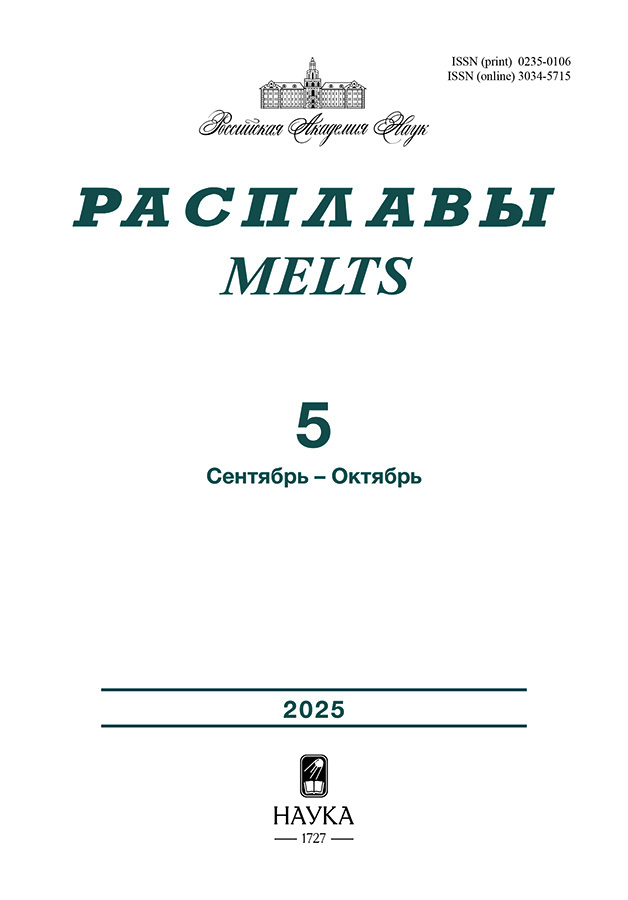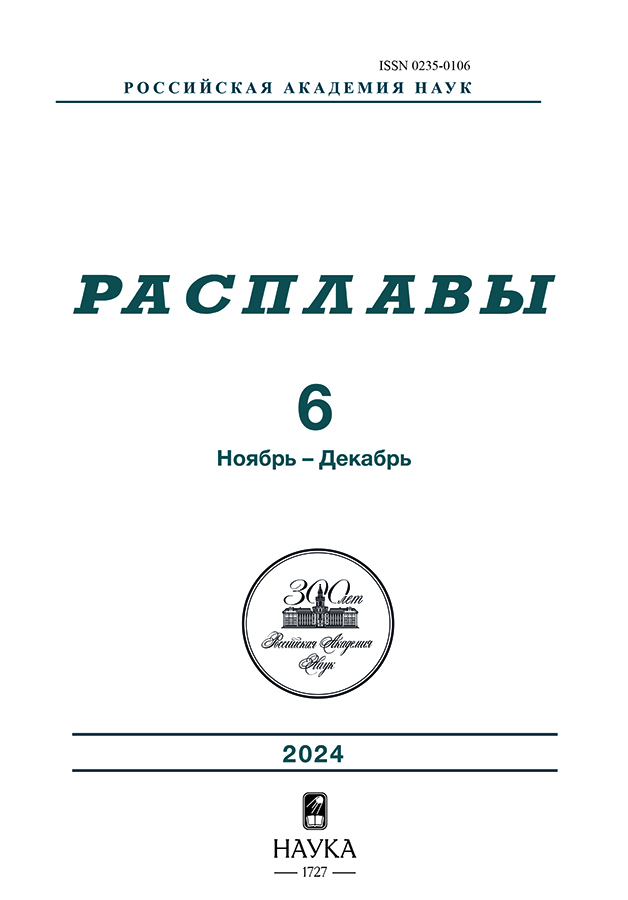Хлорированный графит как положительный электрод алюминий-ионных источников тока с электролитом 1-этил-3-метилимидазолхлорид/хлорид алюминия
- Авторы: Дружинин К.В.1,2, Кукин А.С.2, Балакин К.Ю.1
-
Учреждения:
- Институт высокотемпературной электрохимии УрО РАН
- Уральский федеральный университет им. Б. Н. Ельцина
- Выпуск: № 6 (2024)
- Страницы: 609-623
- Раздел: Статьи
- URL: https://rjmseer.com/0235-0106/article/view/661964
- DOI: https://doi.org/10.31857/S0235010624060037
- ID: 661964
Цитировать
Полный текст
Аннотация
В данной работе определен тип зависимости поляризации катода алюминий- ионного источника тока на основе хлорированного графита исходной марки ЕС-02 в низкотемпературном расплаве хлорида алюминия с 1-этил-3-метилимидазолхлоридом от геометрических характеристик электрода и плотности тока. Определено, что для хлорированного графитного материала величины поляризации немного снижены по сравнению с исходным нехлорированным графитом той же марки в аналогичном расплаве и составляют 25–50 мВ при 1 мА/см2, кроме того, на зависимости поляризации от плотности тока отсутствует излом между значениями 1 и 1.2 мА/см2, характеризующий предельную скорость токогенерирующей реакции на нехлорированном графите и выход к режиму предельного тока, что означает повышение скорости основного процесса на лимитирующем электроде в результате хлорирования. С помощью реперного эксперимента на стеклоуглеродном плоском электроде оценена плотность сорбции хлоралюминатных комплексов по поверхности хлорированного графита, которая для разных площадей электродов и плотностей тока составила величины около 15%. Соответственно, предельная степень интеркаляции для таких материалов равна 6. Поскольку хлорирование графита не приводит к искажениям геометрических параметров межслоевых щелей, установлено, что плотность сорбции хлоралюминат-ионов в результате хлорирования возрастает, в случае нехлорированного графита величина степени интеркаляции варьируется с плотностью тока от 9 до 18.
Ключевые слова
Полный текст
Об авторах
К. В. Дружинин
Институт высокотемпературной электрохимии УрО РАН; Уральский федеральный университет им. Б. Н. Ельцина
Автор, ответственный за переписку.
Email: druzginin@mail.ru
Россия, Екатеринбург; Екатеринбург
А. С. Кукин
Уральский федеральный университет им. Б. Н. Ельцина
Email: druzginin@mail.ru
Россия, Екатеринбург
К. Ю. Балакин
Институт высокотемпературной электрохимии УрО РАН
Email: druzginin@mail.ru
Россия, Екатеринбург
Список литературы
- https://projects.leitat.org/horizon-2020-alion-project-kick-off-meeting-leitat-2/ (accessed 24.03.2024);
- https://graphenemg.com/graphene-products/graphene-aluminium-ion-battery/ (accessed 24.03.2024);
- Brahambhatt R. New aluminum batteries could be the dirt cheap alternative to lithium-ion that we’ve all been waiting for / ZME Science, URL: https://www.zmescience.com/science/news-science/new-aluminum-batteries-could-be-the-dirt-cheap-alternative-to-lithium-ion-that-weve-all-been-waiting-for/ (accessed 24.03.2024);
- Li Q., Bjerrum N.J. Aluminum as anode for energy storage and conversion: A review // J. Pow. Sour. 2002. 110. № 1. P. 1-10.
- Kannan G. N., Desikan P. S. A critical appraisal and review of aluminium chloride electrolysis for the production of aluminium // Bul. Electrochem. 1985. 1. № 5. P. 483-488.
- Gifford R., Palmisano B. An aluminum/chlorine rechargeable cell employing a room temperature molten salt electrolyte // J. Electrochem. Soc. 1987. 134. P. 650–654.
- Zafar Z. A., Imtiaz S., Razaq,R., Ji S., Huang T., Zhang Z., Huang Y., Anderson J. A. Cathode materials for rechargeable aluminum batteries: current status and progress // J. Mater. Chem. A. 2017. 5. P. 5646−5660.
- Lin M.-C., Gong M., Lu B., Wu Y., Wang D.-Y., Guan M., Angell M., Chen C., Yang J., Hwang B.-J., Dai H. An ultrafast rechargeable aluminium-ion battery // Nature. 2015. 520. № 7547. P. 324–328.
- Sun H., Wang W., Yu Z., Yuan Y., Wang S., Jiao S. A new aluminium-ion battery with high voltage, high safety and low cost // Royal Soc. Chem. 2015. 65. P. 15-18.
- Wu M., Xu B., Chen L. Q., Ouyang C. Geometry and fast diffusion of AlCl4 cluster intercalated in graphite // El. Acta. 195. P. 158–165.
- Krapchev, T., Ogivil, R., Dresselhaus, M.S. The effect of intercalation on the lattice constants of graphite // Carbon. 1982. 20. № 4. P. 331–337.
- Pham H. D., Horn M., Fernando J. F. S., Patil R., Phadatare M., Golberg D., Olin H., Dubal D.P. Spent graphite from end-of-life Li-ion batteries as a potential electrode for aluminium ion battery // Sus. Mater. Tech. 2020. 26. P. e00230-1-e00230-6.
- Gao Y., Zhu C., Chen Z., Gang L. Understanding ultrafast rechargeable aluminum-ion battery from first-principles // J. Phys. Chem. C. 2017. 121. P. 7131−7138.
- Fialkov A.S. Uglerod. Mezhsloynyye soyedineniya i kompozity na yego osnove [Carbon. Interlayer connections and composites based on it]. M.: Aspect-Press, 1997. [In Russian].
- Jung S. C., Kang Y.-J., Yoo D.-J., Choi J. W., Han Y.-K. et.al. Flexible few-layered graphene for the ultrafast rechargeable aluminum-ion battery // J. Phys. Chem. C. 2016. 120. № 25. P. 13384−13389.
- Mohandas K. S., Sanil N., Rodrigues P., Noel M. Electrochemical intercalation of aluminium chloride in graphite in the molten sodium chloroaluminate medium // Carbon. 2003. 41. P. 927–932.
- Crone W., Wortmann G., Kaindl G. Intercalation structure in halogen-intercalated graphite // Synt. Metals. 1989. 28. P. F247-F252.
- Suzuki S., Mazej Z., Zemva B., Ohzawa Y., Nakajima T. Surface passivation of natural graphite electrode for lithium ion battery by chlorine gas // Acta Chim. Slov. 2013. 60. № 3. P. 513-520.
- Larkin P.J. IR and Raman spectroscopy. Principles and spectral interpretation. Elsevier. 2011.
Дополнительные файлы


















